As some of my readers know, in addition to being a professional artist; i.e., someone who generates a substantial portion of their income from making and selling their original art, I am also a dealer in ancient art from the Mediterranean world — albeit on a greatly reduced scale the past several years.
Among the forms of ancient art I’ve been most drawn to is glass. In 2010 I took a course in glass flameworking at The Crucible in Oakland, California; about 15 hours worth of instruction. At the time, my objective was not to begin working in glass but to gain some insight into the techniques and technologies available to ancient glass workers, whose products I was dealing in on a daily basis.
Since then I’ve moved across the country (for now, North Carolina) and changed careers. The majority of my income comes from either my own artwork or my “day job” in the fine arts department of a local community college. With a very few exceptions, since 2010 I had not had the opportunity to work in glass. With my employer’s campus currently shut down, I’ve begun pursuing some artistic endeavors that wouldn’t previously have been possible, including glass.

Investing a small sum in a basic torch, a few gas cylinders and other rudimentary equipment, I’ve been making glass beads, pendants and other small objects since April of this year. Only in the last few days did I realize the extent to which my previous role in dealing with countless ancient glass beads, pendants and amulets was impacting the direction of my current glass working. This post is an exploration of that experience, largely in pictures.
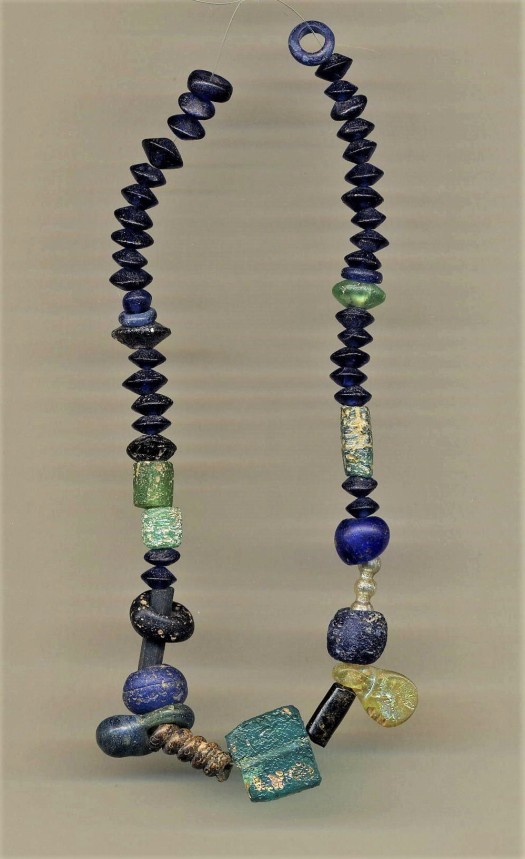
Beads and related small objects in glass have been made since the Bronze Age, 3,500 years ago, beginning in Mesopotamia and Egypt. The image above shows a restrung ancient Roman glass bead necklace. Most of the beads are 1st-2nd Century CE (I use BCE and CE instead of BC and AD, as is currently accepted academic practice). Most of these beads are discoid, tubular, donut and even flattened square beads of a single color. The iridescence on some of them is purely the result of burial in soils that were either quite acidic or alkaline. These are simple to make in large numbers, as they have no special ornamentation. Also included with string of beads, near the bottom of the photo, are 2 pendant beads; that is, beads that hang down like a pendant, one in very dark blue or black glass and one in a light yellow-green. Also visible, just above the pendant bead on the right and just below the pendant on the left, are tubular beads with spirals or ridges. These have been shaped by rolling over a textured marver while red hot.

Here are some very simple, transparent, one color beads that I made, somewhat like those in the previous image. Simple and easy to make in quantity. It should be noted that all the examples I will show here of my own work are made with borosilicate glass, not the softer soda-lime glass used in antiquity.

Some simple pendant beads I’ve made, not much different to the Roman examples in the first image above.

I made the textured coil bead above in basically the same way as the two examples in the string of Roman beads in the first image above. The only difference being that I’ve used multiple colors in a single bead.
The use of trailing, that is, applying one or more threads of a contrasting color of glass over a monochrome bead, and either stopping there or dragging the trail in an up and down motion with a pointed metal tool to create a feathered pattern, was a technique very commonly used by ancient and medieval glass beads makers.
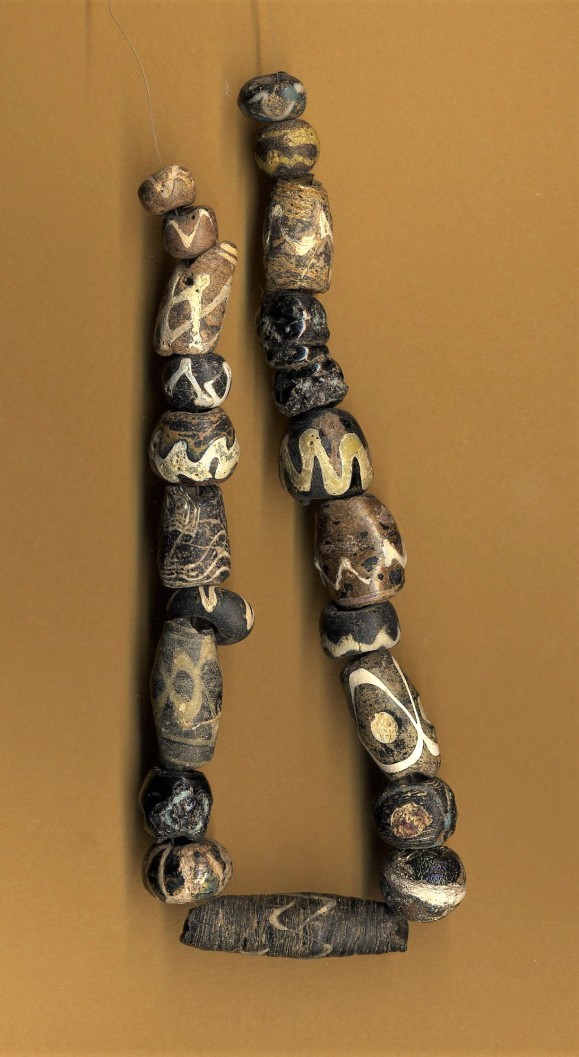
The image above shows a Roman glass bead necklace from the Levantine coast, dating to the 3rd or 4th Century AD. The glass is either black or very dark purple appearing black, with trails of white applied and flattened out on a stone or metal marver.

I made these simple beads of cream white with applied threads of black that I dragged with a metal tool to create the feathered pattern; a bit like marbled paper.

The image above is a string of black glass beads — again, Roman — that have been rolled in a pile of small glass chips while red hot and the chips marvered into the surface . Modern glass artists refer to this material as frit.

Using the same technique shown in the previous image, I made these beads, one clear and one milk white, and rolled them in a layer of frit. I make my own frit from the broken or discarded bits of glass that the process inevitably generates. Some flameworkers use sifters to sort out frit into different sizes for a range of applications.

The image above, probably made at Carthage between 600 and 250 BCE, is characteristic of a type of “eye bead” made throughout the Mediterranean world and beyond from New Kingdom Egypt right through to the Medieval Islamic period. The eyes were thought to ward off evil. In fact, protective eye beads and amulets in glass are still made and used today in Turkey, Greece, Cyprus and other eastern Mediterranean countries. Because this example has layers in its eyes, it is called a composite eye bead.

And in this image are a few beads I’ve made with both simple and composite eyes in various colors.
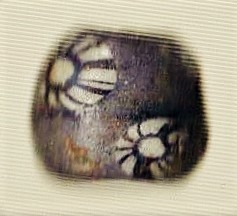
This image (a scan, so I apologize for the image quality) is a glass bead made in Alexandria (Roman Egypt) in the 1st or 2nd Century CE. Here the craftsman has applied slices of pre-made 2 color glass cane to the surface of a monochrome glass bead. Although this technique is quite ancient, it was revived by Venetian glass makers in the Renaissance. Today the term for this type of glass is millefiori (Italian for “thousand flowers”).
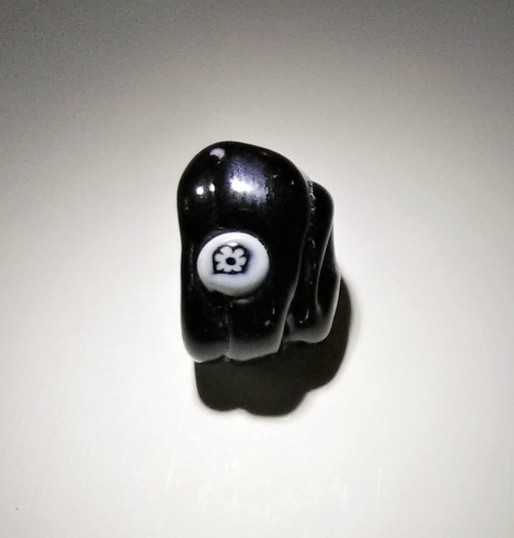


In these 3 images, I’ve used exactly the same technique as on the Alexandrian bead.
I’ve only just begun my self-guided exploration of the world of glass making. In the long term, I hope to acquire higher quality equipment and expand the range of work to include glass fusing, mosaic and slumping. Finding my own voice in this medium, as with any newly adopted medium in art, may take some time. I hope to share that experience with my readers.
One last image — a glass inlay plaque, now in the Corning Museum of Glass, Corning, NY, from Roman Egypt, late 1st Century BCE to 1st Century CE. During the Greek Ptolemaic and Roman periods in Egypt, spanning roughly 600 years, Egyptian glassmakers created works of astounding complexity, technical prowess and subtlety. This little plaque, possibly a furniture inlay, with a griffin, its paw raised, is just a taste of those achievements.

Finally, a few links (all these open in a new window or tab).
For those with an interest in learning glass making in all its forms, there are many art schools offering classes to the public. I can only list a couple here, that I know from firsthand experience and can recommend. Hopefully, these will be open again once the immediate danger from Covid-19 has passed. —
On the West Coast, The Crucible: https://www.thecrucible.org/about-the-crucible/
On the East Coast, https://penland.org/
On YouTube —
Lu Libby https://www.youtube.com/user/manofglassfire/about Straightforward watch and learn videos from an experienced glass worker, both torch and blown glass. Loads of videos, fun to watch.
Corning Museum of Glass – https://www.youtube.com/user/corningmuseumofglass Countless videos of work in detail by some of the world’s greatest glass artists. Also videos of museum staff recreating historic glass objects from all periods.


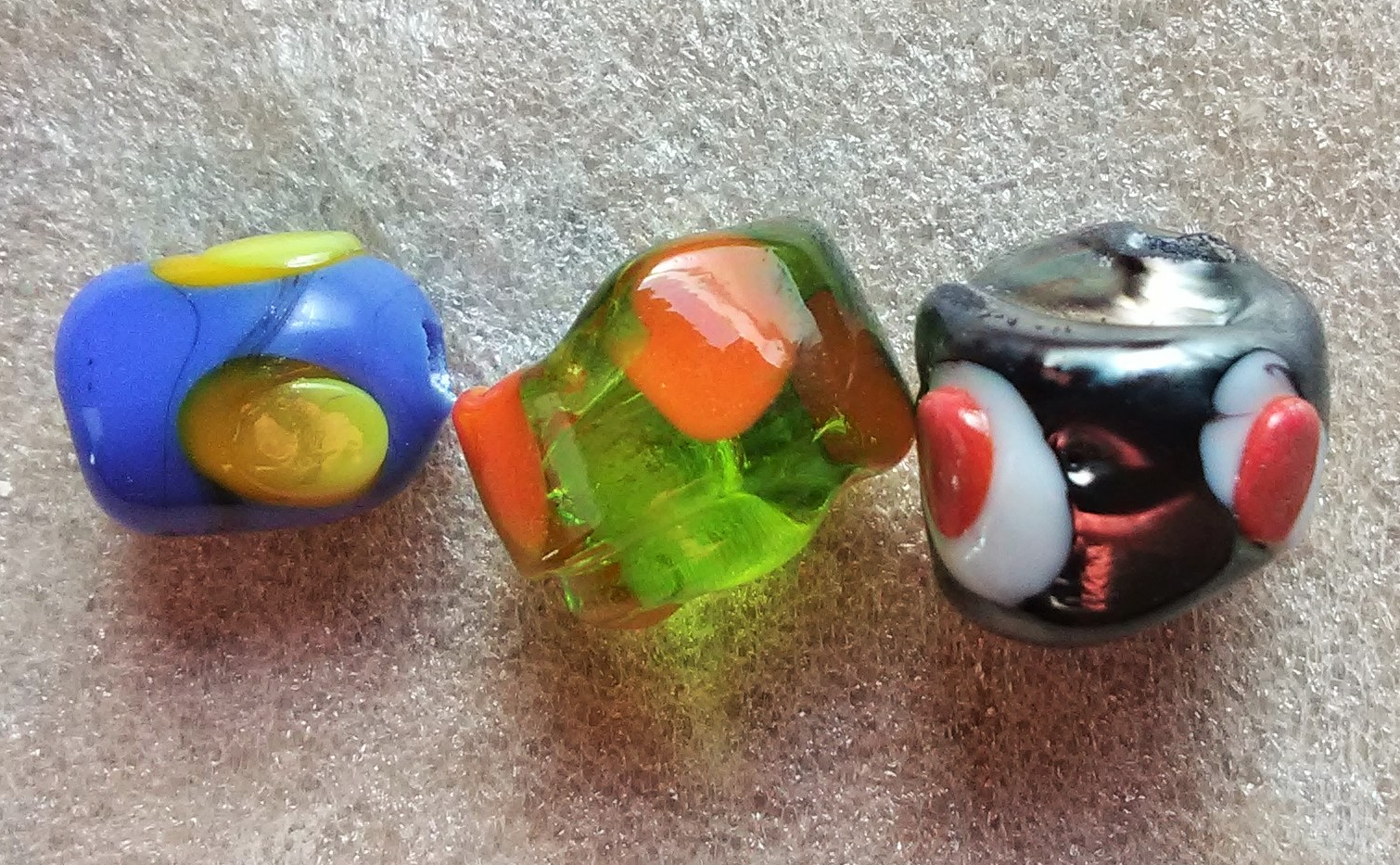

2 Replies to “Learning the art of flamework glass during lockdown”